A bowl of hot oatmeal on a chilly morning has been a comfort staple breakfast for generations, and most people know that oats are a “heart healthy” cholesterol-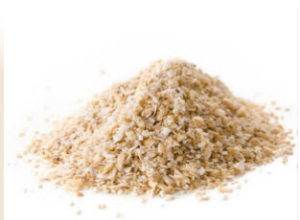 lowering food. However, the most virtuous and versatile component of the oat resides in its outer layer—the bran. The bran contains a high content of a unique type of soluble fiber called beta-glucan, which bestows some remarkable health properties, and is incredibly beneficial for weight loss.
lowering food. However, the most virtuous and versatile component of the oat resides in its outer layer—the bran. The bran contains a high content of a unique type of soluble fiber called beta-glucan, which bestows some remarkable health properties, and is incredibly beneficial for weight loss.
Technically, oat bran is not a whole grain (since it’s actually only one part of the oat grain). But because of its exceptionally high fiber content, it can be considered a whole grain. A bowl of oat bran contains about 50% more fiber than the same size bowl of oatmeal, making it more effective at lowering cholesterol and in its weight loss properties. And because it is mostly fiber, oat bran has less calories than the same amount of oatmeal. A three-quarter-cup serving of cooked oat bran contains only 66 calories, compared to 124 calories in the same amount of cooked oatmeal. Oat bran also has more antioxidants, protein, calcium, iron, thiamin, phosphorus, riboflavin, magnesium, and zinc than oatmeal.
Aside from fewer calories, there are two other combined properties that make oat bran a powerfully slimming food. First, because of it high fiber content, oat bran satiates you. As soon as you ingest it, the fiber in oat bran soaks up saliva and then expands in the stomach absorbing up to 25 times its volume in liquid, making you feel quite full, quite fast. It provides a prolonged feeling of fullness, so you eat less in between meals.
The second way that oat bran helps with weight loss is more biologically unique. It’s called intestinal caloric loss. In other words, oat bran blocks the absorption of calories from the intestine. Here’s how it works: when you eat food, it is broken down into it’s individual components of fatty acids, carbohydrate (glucose) and amino acids (the building blocks of proteins). The calories from these components are then absorbed into the body. But when you eat oat bran, it mixes with water in your intestine to produce a gel-like substance called bolus. The bolus absorbs some of the breakdown products, and then it is attacked by gastric juices and stomach acids that turn it into a pulp. This pulp becomes part of the stool, and thereby carries the calorie-dense components of fats, glucose, and amino acids out of the body through the stool. This process both slows down the assimilation of sugar (glucose) and removes calories from the body while keeping your blood sugar levels low and stable.
One key to make this action more effective is to reduce or eliminate other grains in the diet, especially wheat, and put oat bran in their place.
So how do you eat it? Here are some ideas:
- Oat bran can be cooked as a hot cereal by mixing 1 part oat bran to two parts water and cooking it the same as you would cook oatmeal
- Add a tablespoon or two to your yogurt, cottage cheese or a smoothie
- Add it to an omelet
- Bread meat, poultry, or eggplant with it
- Sprinkle it on salad
- Use it in place of bread crumbs when making meatloaf, meatballs and burgers
- Mix it in a soup or stew
- Make flourless muffins and pancakes with it
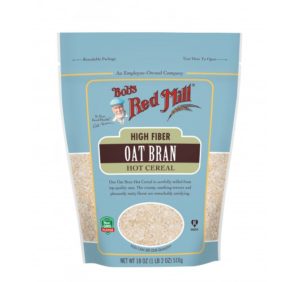 Oat bran is available in the cereal or bulk section of major grocery stores and natural food stores. Since oat bran contains a small amount of naturally-occurring fat, it is susceptible to going rancid. Look for products in well-sealed packaging. Quaker Oats sells it in a 1-pound box that you will find in the hot cereal section of most grocery chains. Bob’s Red Mill also sells it in a 1-pound clear plastic package. If you’re buying from a bulk bin, buy from a store that has a high product turnover, and be sure the product is free from any moisture (visible as clumps) and has a faint nutty smell.
Oat bran is available in the cereal or bulk section of major grocery stores and natural food stores. Since oat bran contains a small amount of naturally-occurring fat, it is susceptible to going rancid. Look for products in well-sealed packaging. Quaker Oats sells it in a 1-pound box that you will find in the hot cereal section of most grocery chains. Bob’s Red Mill also sells it in a 1-pound clear plastic package. If you’re buying from a bulk bin, buy from a store that has a high product turnover, and be sure the product is free from any moisture (visible as clumps) and has a faint nutty smell.
Due to its susceptibility to going rancid, store oat bran in a tightly sealed container in a cool, dark and dry place. To prolong the shelf life of oat bran, store it in the freezer in a tightly sealed container. You can cook with oat bran directly out of the freezer in recipes or on its own – no thawing required.
You can purchase a Gluten-Free version of Bob’s Red Mill’s Oat Bran by clicking below:
Here are some other options for you to consider:

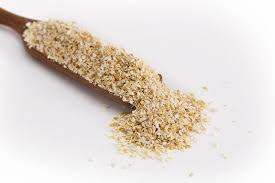
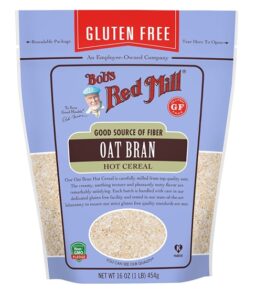
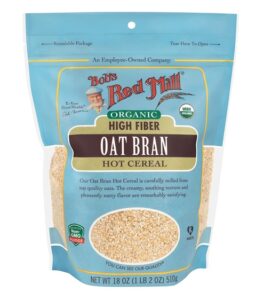
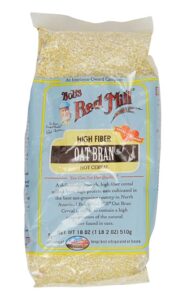
Hi Dee, I was wondering which is better for your health and weight loss, Oat Bran or Wheat Bran?
Hi Lisa,
Generally I recommend oat bran over wheat bran, mainly because oat bran has been used as part of a weight loss plan by many people that I know and have worked with as clients over the years. Oat bran is the featured ingredient in my oat bran muffin bran muffins that used to sell at Sprouts and Whole Foods for many years.
Also, oat bran is gluten-free, while wheat bran is not. Gluten can be inflammatory for many people. The biggest difference between the two is the type of fiber each contains. Oat bran contains soluble fiber, specifically a type called beta-glucan, that may help prevent heart disease, lower cholesterol, and manage diabetes. The beta-glucan binds to cholesterol in the intestine, transporting it through the digestive tract and and eliminates it through bowel movements.
Wheat bran has insoluble fiber, which adds bulk to the stool, helping food transport through the stomach and intestines, but it doesn’t lower cholesterol.
The most important thing about either oat bran or wheat bran is portion size. Proper portion sizes are key to health and weight loss.